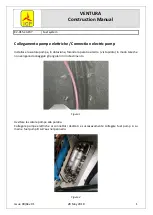
19
Rotational speed in the spiral increases with further brake input. Once in the spiral, speed
and diving angle can be increased or slowed down by varying the brake input by a few centimeters.
With a bit of experience a spiral enables sink rates of more than 10 m/s.
Fast or poorly synchronized brake-input or very steep spirals can lead to asymmetrical collapses
or a flat spin.
Because of high sink rates and a possibly demanding exit we recommend not to perform
this manoeuvre below 100 m above the ground.
Caution: A spiral is not a simple manoevre. The kinetic energy built up must be controlled
by releasing the brakes. Clean entry and exit have to be trained in flying schools
and must be refreshed repeatedly.
C.
B-stall
Grasp the B-risers (second riser counted from the front backwards) near the quick links
and pull down symmetrically.
The wing centre will deform slightly and the wing will fall back, then stabilize above the pilot
and provide a sink rate of 6-8 m/s.
Exit the B-stall by symmetrically releasing both B-risers quickly. The ATIS 3 will instantly
adopt trim speed.
Summary of Contents for atis 3
Page 1: ...English 2010 ...
Page 9: ...9 1b Line plan ...











































